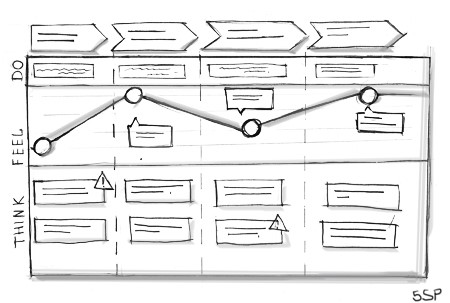Creating Competitive Advantage on the Market
In the recent years, customer retention has become a measure of competition amongst brands. In order to keep existing customers, brands have to understand their needs and how they interact with the brand. Only after gathering and analyzing this information, can they offer a product or provide a service that would fulfil their customers’ needs. The customer experience (CX) that brands provide during the journey of their customers helps people to decide between different buying options. The ultimate goal of every business is to make this decision making process easier for the customer and help them to achieve their goals effortlessly.
Customer Journey Map as a Tool
In order to turn the above mentioned idea into an action, brands need a tool that help them to identify the journey their customers take. This is when customer journey maps come in the picture. But what is a customer journey map exactly?
“A customer journey map is a visual representation of the activities and situations a customer goes through before, during, and after engaging with a service.” (Marc Fonteijn)
The visual journey map helps to understand the customer perspective, and find any gaps or pain points where the ideal retail space differs from the actual one. Brands can use journey maps to track customer interaction and analyze their touch points inside the store. Taking omni-channel strategy into account, these touch points for their customers can occur at any point on their various retail channels. Though not every customer will follow the same journey, analyzing this data helps brands to identify trends by showing them the “most likely path” their customers will take.
What is the outcome? What do we want to achieve by creating customer journey maps?
Advertisement
• Better understanding of the customer
• Discovering the pain points of the customer journey where the brand is falling short of consumer expectations
• Utilizing it as a marketing tool
• Creating a visual that will help the whole company to better understand how the service process should look like
A report from 2018 shows that 67% of the surveyed business professionals are using or have used customer journey mapping and almost 90% of them said they experience a positive impact in customer satisfaction.
Essential Elements to Create a Customer Journey Map
Even though the aim of a customer journey map is to have a very simple, easy to read and understandable design, there is a lot of research, analysis, and work required to ensure a simple end result. Without enough detail, a journey map has no use, but too much detail can overwhelm people and they can easily lose focus without understanding the map.
As a first step, brands have to create a buyer persona and understand his/her goals. Only after that can they start to map their interaction with the company.
Here are 5 of the most important elements that brands need to understand when creating a customer journey map:
1. Customer lifecycle: This part is the stages or phases of the journey. They can refer to a time (before, during or after the purchasing process) or alternatively, they can represent an action as well (brand awareness, planning, purchase, delivery, installation, usage, and repair).
2. Customer activities and situations: This part includes those relevant activities that the customer does and those situations, circumstances that have a significant influence on their experience.
3. Customer needs: This is an extremely subjective part which is connected to the customer who's going through this specific journey and shows the requirements at each stage.
4. Customer experience: This curved line shows how satisfied or dissatisfied the customer is throughout the journey.
5. Extra elements: Communication channels, Back-end processes or IT Systems.
Advertisement
Benefits for the Brand
The customer journey map gives an important perspective to brands allowing them to see how their existing and potential customers actually experience the brand. Understanding this allows them to compare this result with the ideal “perfect” scenario.
Based on Aberdeen Group research (2016) using a customer journey map will result in 54% greater return on marketing investment and 56% more cross- and up-sell revenue. It also can generate 24% more positive mentions on social media platforms and 18 times faster average sales cycle.
When consumers can achieve their goals along their journey path, they will be more satisfied by the end of the journey. Higher satisfaction of consumers increases their brand loyalty which makes them more likely to shop with the same brand again. Improved customer experience also leads to lower operational costs, and increases profits for the brand.
Image Source: 5 Star Plus Retail Design
Advertisement


 Photo Gallery3 days ago
Photo Gallery3 days ago
 Headlines2 weeks ago
Headlines2 weeks ago
 Sector Spotlight2 weeks ago
Sector Spotlight2 weeks ago
 Headlines1 week ago
Headlines1 week ago
 Headlines5 days ago
Headlines5 days ago
 Headlines2 weeks ago
Headlines2 weeks ago
 Designer Dozen1 week ago
Designer Dozen1 week ago
 Headlines3 days ago
Headlines3 days ago




















